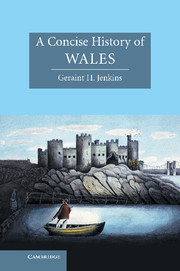Book contents
- Frontmatter
- Contents
- List of illustrations
- Preface
- 1 The earliest inhabitants
- 2 The Heroic Age, 383–1063
- 3 The Anglo-Norman conquerors, c. 1063–1282
- 4 Pestilence, rebellion and renewal, c. 1283–1536
- 5 Early modern Wales, 1536–1776
- 6 A crucible of the modern world, 1776–1900
- 7 Wales awakening? 1901–2006
- 8 Whither Wales?
- Sources of quotations
- Guide to further reading
- Index
- CAMBRIDGE CONCISE HISTORIES
5 - Early modern Wales, 1536–1776
Published online by Cambridge University Press: 05 June 2014
- Frontmatter
- Contents
- List of illustrations
- Preface
- 1 The earliest inhabitants
- 2 The Heroic Age, 383–1063
- 3 The Anglo-Norman conquerors, c. 1063–1282
- 4 Pestilence, rebellion and renewal, c. 1283–1536
- 5 Early modern Wales, 1536–1776
- 6 A crucible of the modern world, 1776–1900
- 7 Wales awakening? 1901–2006
- 8 Whither Wales?
- Sources of quotations
- Guide to further reading
- Index
- CAMBRIDGE CONCISE HISTORIES
Summary
In the twenty-seventh year of the reign of Henry VIII, a Putney-born state-builder set Wales on the path towards integration within a Greater Britain, a process which reached its conclusion with the Anglo-Scottish Union in 1707 and the Union of Great Britain and Ireland in 1800. Such a future, of course, was hardly discernible in 1536 to Thomas Cromwell, the king's chief minister and the architect of the Act of Union (1536), for he was essentially a ruthless pragmatist whose incorporation of Wales into England was part of an overall strategy of recasting diverse elements of the commonwealth into a unitary state. Although he was a master of the perfidious politics of his age, Cromwell was no stranger to Erasmian idealism nor did he lack creative intelligence. The cornerstone of his policy was the concept of ‘unification’, and he was determined to bring good governance to Wales. Cromwell went to the block at the command of his royal master in 1540, but by that stage he had begun a new drive to impose order and ‘civility’ upon the Welsh within an administrative and legal dispensation known as ‘England and Wales’. His blueprint stood the test of time: the Act of Union remained on the statute books until 1993.
In the sixteenth year of the reign of George III, a Llangeinor-born philosopher, writing at a time when British authority in colonial America was disintegrating, published a pamphlet which provided the thirteen American colonies with a powerful ideological justification for rising in rebellion.
- Type
- Chapter
- Information
- A Concise History of Wales , pp. 131 - 172Publisher: Cambridge University PressPrint publication year: 2007

